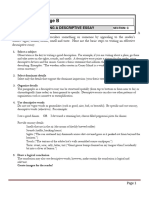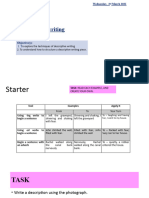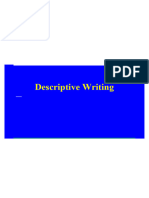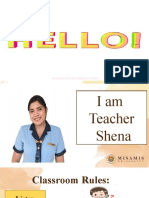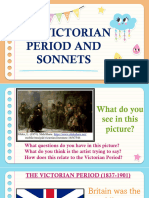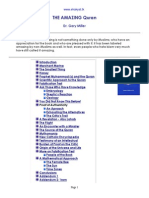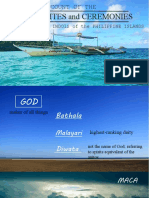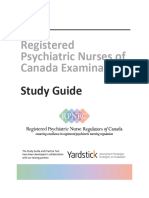Notes and homework
Descriptive writing
Descriptive writing is a style of writing that gives a clear and detailed picture of a place,
person, or thing. The main goal is to help the reader imagine the scene as if they were really
there. To do this, the writer uses details that appeal to the five senses, sight, sound, smell,
taste, and touch. If the reader can clearly picture what the writer is describing, then the writer
has done a good job with their descriptive writing.
For example:
Apple: You can see, touch, and taste an apple.
Dog: You can hear a dog barking, see it running, and pet its fur.
Car: You can touch the car, hear the engine, and see it moving on the road.
1
�ABSTRACT NOUNS
He gains immense satisfaction from helping poor animals
That is a brilliant idea.
When he won the first prize, his joy knew no bounds.
People often took advantage of his generosity.
Sensory details
Appeal to the 5 senses – sight, sound, touch, taste, smell.
often adjectives or adverbs. “Show; don’t tell”
EXAMPLES
Using Sensory Details
Vague: The sunset was beautiful.
Concrete: The sunset glowed with orange light.
Vague: She has a terrible singing voice.
Concrete: Her singing voice reminds me of a litter of angry cats scratching a
chalkboard.
Vague: I enjoyed the pie.
Concrete: The sweet and spicy pumpkin pie makes our house feel like Christmas.
Vague: This sweater is so uncomfortable.
Concrete: This itchy sweater is giving me a rash.
2
�Provide sensory details:
1.Smells that are in the air (the aroma of freshly brewed coffee)
2.Sounds (traffic, honking horns)
3.Sights (“The sun scattered tiny diamonds across dew-covered grass as it peeked out from
beyond the horizon.”)
4.Touch (“The texture of the adobe hut’s walls resembled coarse sandpaper.”)
5.Taste: sweet, sour, salty, bitter, tart (“Giant goose bumps formed on my tongue when I
accidently bit into a sliver of lemon.”)
Examples of Concrete Sentences
Concrete sentences bring your writing to life. They cut through the fog of vague language and
make your points obvious, like a pair of welding goggles in a dark room.
Everyday Life Scenarios
Cooking: Instead of saying, “I made dinner,” say, “I grilled a juicy chicken breast,
marinated in zesty lemon and garlic.” Now your mouth’s watering, right?
Traveling: Swap “I visited a city” for “I strolled through Rome’s cobbled streets, savoring
gelato dripping on my hand.” Now that’s a vacation!
Shopping: Ditch “I bought groceries” for “I scored three ripe avocados, six fresh tomatoes,
and two pounds of pasta at the farmer’s market.” You’re not just shopping—you’re a
culinary treasure hunter!
Read the text below.
The landscape was full of mystery and of life. The autumn was in full bloom. The sun cast a
golden light upon the adobe walls and the cornfields; it set fire to the leaves of willows and
cottonwoods along the river; and a fresh, cold wind ran down from the canyons and carried
the good scents of pine and cedar smoke, of bread baking in the beehive ovens, and of rain in
the mountains. There were horses in the plain and angles of geese in the sky.
N. Scott Momaday
Answer the questions.
1.What is the topic sentence?
--------------------------------------------------------------------------------------------
2.Identify the concrete and sensory details in the text.
--------------------------------------------------------------------------------------------
Instructions: Identify the abstract nouns in the following sentences.
We felt a sense of relief after the exam.
Happiness filled the room as they celebrated their victory.
3
�Courage is needed to face challenges.
Love is a powerful emotion.
Freedom is a precious right.
Justice should prevail in every situation.
Peace is essential for a harmonious society.
Hope keeps us going through difficult times.
Beauty is in the eye of the beholder.
Intelligence is a valuable asset.
Instructions: Read the following paragraph and identify the abstract nouns.
The little girl felt a sense of excitement as she opened her presents on Christmas morning.
She was filled with gratitude for her generous parents. As she played with her new toys, she
experienced pure joy. She couldn’t help but feel a sense of belonging and love surrounded by
her family.
Underline the concrete nouns int the sentences.
I ate an apple for breakfast this morning.
The table in the dining room is made of solid wood.
I like to sit in my comfortable chair when I read a book.
My dog loves to play fetch in the park.
My cat always naps in the sunniest spot in the house.
I need to charge my phone before I leave the house.
I drove to work in my new car today.
The tree in my front yard is a maple.
I love the colour of the paint on my house.
Please close the door behind you when you leave.
I like to open the window in my bedroom for fresh air.
I can’t find my key to the front door.
I need to write a letter with a black pen.
I prefer to use a mechanical pencil for drawing.
I read an interesting book last night before bed.
4
�I like to watch movies on my new television.
I turned on the lamp to read in bed.
My new bed is very comfortable.
I need to buy a new pillow for my bed.
I’m going to snuggle under a warm blanket on the couch.
SpatialTransitions
It is the method of organizing written text in a sequence that makes sense to readers in
descriptive essays. You can also refer to this organization method as “chronological” or
“time.” Spatial order definition includes putting things into their logical and physical space,
which helps with reading comprehension because if something is out of place, it will not
make sense.
Indicate where things are
Flow logically through space/description
Near to far
Top to bottom
Left to right
Next to
Firstly, secondly, thirdly etc.
Opposite
Nearby
Identify spatial transition
The sun was still red and large: the sky above cloudless, and light blue glaze poured over
baking clay: but close over the ground a dirty grey haze hovered. As they followed the lane
towards the sea they came to a place where, yesterday, a fair-sized spring had bubbled up by
the roadside. Now it was dry. But even as they passed some water splashed out, and then it
was dry again, although gurgling inwardly to itself. But the group of children were hot, far
too hot to speak to one another: they sat on their ponies as loosely as possible, longing for the
sea.
5
�Activity
Rewrite each sentence of the following. Include concrete, descriptive language
and specific details. You may break up each sentence into multiple sentences.
Add identifying details where they are lacking.
Delete all empty words and replace them with descriptive words.
Use at least one sensory detail in each sentence.
Use at least one simile or instance of personification in the exercise.
“Zen Restaurant is my favourite place in town. They have a great food selection, and the
workers/staff are cool. The restaurant also has fun activities on certain nights, and I love the
décor. The only drawback is the slightly inconvenient location. As far as restaurants go, it’s
definitely better than others nearby.”
Sentence1 1:
…………………………………………………………………………………………………
…………………………………………………………………………………………………
…………………………………………………………………………………………………
…………………………………………………………………………………………………
Sentence 2
…………………………………………………………………………………………………
…………………………………………………………………………………………………
…………………………………………………………………………………………………
…………………………………………………………………………………………………
Sentence 3
…………………………………………………………………………………………………
…………………………………………………………………………………………………
…………………………………………………………………………………………………
…………………………………………………………………………………………………
Sentence 4
…………………………………………………………………………………………………
…………………………………………………………………………………………………
…………………………………………………………………………………………………
…………………………………………………………………………………………………
Sentence 5
…………………………………………………………………………………………………
…………………………………………………………………………………………………
6
�…………………………………………………………………………………………………
…………………………………………………………………………………………………
Figurative Language
Figures of speech are imaginative comparisons between two basically dissimilar things. A figure of speech
may enliven a description by making the essay more visual or forceful.
Here are some of the more common figures of speech that could prove effective in writing descriptive
essays:
Simile Using the words such as “like” or “as” when comparing.
Example: A ride to North Hutchinson Island is like a flight to a Caribbean
getaway.
Metaphor Implying a comparison between two things that are essentially different.
Example: Stalking their prey, the deputies remained hidden in the bushes
and ready to spring on speeding motorists.
Personification Giving human characteristics to inanimate objects.
Example: The truck, covered with mud and love bugs, cried out for a wash.
Overstatement or Using a figure of speech in which exaggeration is used for emphasis or effect.
Hyperbole Example: I’ll die if I don’t pass this exam.
Writing something opposite to what is expected or says something less than
Understatement
expected.
Example: Yesterday was a little cool. The high temperature was zero
degrees.
Sound words or Using words that imitate the sounds associated with the objects or actions to
Onomatopoeia which they refer.
Example: “Plop, plop, fizz, fizz, oh what a relief it is.” (slogan of Alka
Seltzer)
Symbol A person, place, or thing that represents an abstract idea or concept.
Example: A rock is a symbol of strength
E-7 Descriptive Essay Guidelines (July, 2011; g:ASC:EngRead) Page 2
7
�- Arin B. Terwilliger
Description Sample
Summer Escape
Title:
Notehowcreativetitlerelates to
essay. My family has always looked forward to leaving Florida during
the torrid summer months. It is a tremendous relief to get out of
Introductoryparagraph: the heated hustle and bustle of summer living in Florida. Each
Firstparagraphsets thestage: summer, we follow the yellow brick road to our hometown in
wheretheactionhappened, whenit upstate New York.
happened, andtowhomithappened. As we drive through state after state, it becomes apparent that
Notedescriptivewords. the world around us is changing. In South Carolina, we already
begin to notice changes. The trees appear to be touchable,
Firstbodyparagraph: offering soft, plush leaves which sway in the breeze, and the
Notehowwriter provides details, grass actually invites us to share its place rather than scaring us
translatinganexperienceintowritten
away with mounds of intruding fire ants. As each state brings
words thatpermitthereader to
visualizethesituation. Note new surroundings, our anticipation builds, and home seems closer
descriptivedetails. all the time.
Leaving the flatlands and entering an area where we are
Tense: suddenly surrounded by hills of purple and blue are by far the
This essayis writteninthepresent most awakening moments. Virginia and Pennsylvania offer
tense; mostnarratives, however, will brilliant scenery with majestic hills and checkerboard
bewritteninthepasttense. Either farmlands. As we descend through the curves and winds of the
tensecanbeeffective. northern region of the United States, home is now very close: we
are almost there. Suddenly, we have driven from wide-open
Secondbodyparagraph: flatlands to a narrow, winding road surrounded by hillsides of
Noteuseof details, especially
stone and trees. Around every curve, orange and black tiger
adjectives. Writer makesuseof
figurativelanguage(personification- lilies claim their place in the world as they push themselves
flowers "wavinghello"). out toward the car, waving hello and flashing their
mysterious black spots toward us as we drive by.
Thirdbodyparagraph: The journey home is almost complete. As we begin our final
Writer continues toappeal to descent through the state of Pennsylvania into upstate New
readers' senses withvisually York, the surroundings become comfortably familiar. Before
descriptivewords. Figurative long, we are welcomed by a sign that reads “Waverly, 18miles”
languageis againusedwiththe and the familiar fields of grazing cattle. Through the last stretch
simile"likeacarriagecreatedby of Pennsylvania, the bursting foliage seems to envelop us and
nature." carry us over the hills like a carriage created by nature.
It is at this point that our family, even the youngest member,
Imagery:
Notehowthewriter creates images knows that our vacation in New York is about to begin. Our
for thereader(boldtype) by eldest son has joked for years that he can “smell” Grandma’s
appealingtothesenses. apple pie already. Approximately fifteen minutes pass and as our
vehicle takes us over the final crest, we see the smoke stack
Conclusion: from the local factory as we cross the border of Pennsylvania
Writer alludes toanother sense and New York and are aware of our surroundings. A couple of
(smell) anduses words toindicate turns later, we are there. We have reached our destination; we are
closing("final crest"). Essayends home.
withstrongconcludingsentence.
8
�My favourite place
My favourite place in the whole world is my grandmother's garden. It's not just a garden; it's
a magical world full of wonders. When I step into that garden, I feel like I'm in a different
universe.
Introduction:
My grandmother's garden is a small piece of paradise tucked away in our backyard. It might
seem ordinary at first glance, but to me, it's a place of endless fascination and beauty.
Body Paragraph 1:
As I open the creaky gate and enter the garden, the first thing that hits me is the scent of a
thousand flowers. The air is filled with the sweet perfume of roses, the zesty aroma of
lemons, and the earthy scent of freshly turned soil. It's a symphony of fragrances that delights
my senses.
Body Paragraph 2:
The garden is a riot of colours. There are vibrant red roses, sunny yellow daffodils, and
delicate blue forget-me-nots. In the middle of it all, a majestic oak tree stands tall, its
branches offering a cool shade on hot summer days. The colourful flowers and the towering
tree create a picturesque scene that's hard to forget.
Body Paragraph 3:
My favourite spot in the garden is a small, moss-covered bench under the oak tree. From
there, I can watch the butterflies dance among the flowers and hear the birds singing their
melodious tunes. It's a place of peace and tranquillity, far away from the noise of the world.
Conclusion:
My grandmother's garden is not just a place with beautiful flowers and trees; it's a place
where I make precious memories. Whether it's playing hide and seek among the rose bushes
or listening to stories under the oak tree, this garden holds a special place in my heart. It's my
little corner of the world where I can escape, dream, and find endless joy.
9
�Homework (Descriptive writing)
Write a 5 paragraphs descriptive essay. Your essay must include all the following details.
● Follow the writing process.
● Use concrete and sensory details.
● Use spatial transitions.
● Use figurative language; simile, metaphor, personification, hyperbole, etc.
● 5 paragraphs (introduction, body paragraphs and conclusion)
Choose 1 topic from the list below.
Describe your favourite place.
Describe your ideal bedroom.
Describe the house in which you grew up.
Describe what the first house on the moon would look like.
Describe some of your favourite places in your hometown.
Describe a peaceful place that you’ve visited.
Describe a place that exists only in your imagination.
Describe a friend’s or family member’s house where you enjoy spending time.
Describe your perfect fantasy vacation destination.
Describe your favourite store.
Describe your favourite teacher’s classroom.
Describe a museum that you’ve visited recently.
Describe a place you have dreamed about that doesn’t exist in real life.
Describe a place where your pet likes spending time.
Describe an outdoor place that you know well.
10














